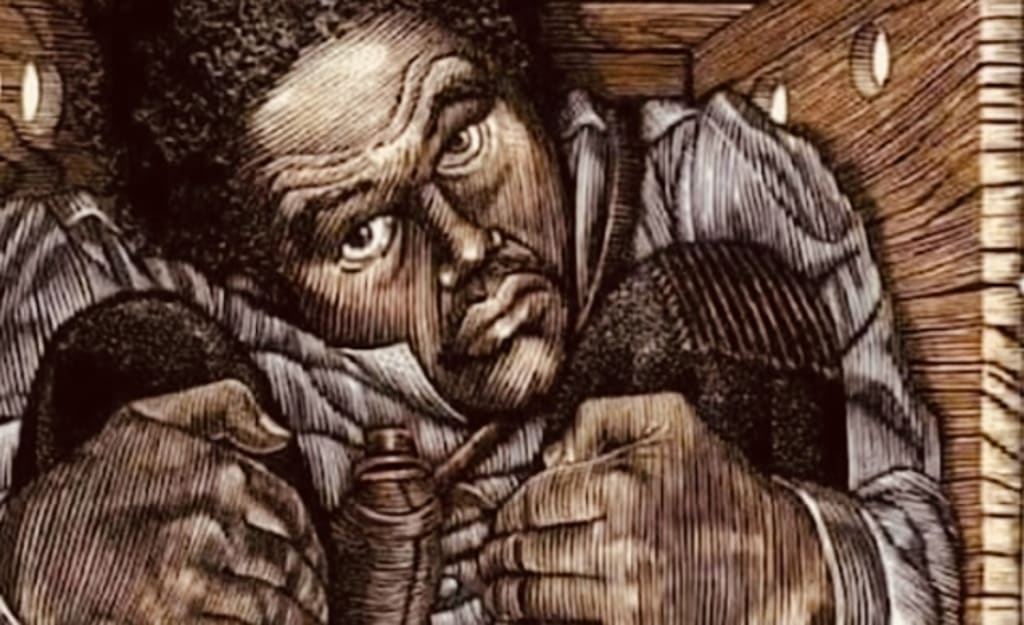The slave who Boxed and shipped himself
He literally shipped himself!

My dear Henry Box,
My heartfelt condolences and admiration for your fortitude and strength of character.
As I reminisce on your life, I am filled with wonder and awe at the lengths you had to go to in order to gain your freedom. A man who wass willing to live, sacrifice or die for what he truly believed in. I wanted to consider you a hero, but unfortunately, other disturbing information has come to light.
I hope that I will do justice to your tale of centuries past but not forgotten.
Here is a snapshot of your story as it was regaled to me not long ago:
Henry Brown was born into slavery in 1815 or 1816 on a plantation called Hermitage in Louisa County, Virginia.
Brown was first married to a fellow slave, named Nancy, but their marriage was not recognized legally. They had three children born into slavery under the partus sequitur ventrem principle. Brown was hired out by his master in Richmond, Virginia, and worked in a tobacco factory, renting a house where he and his wife lived with their children. Brown had also been paying his wife's master not to sell his family, but the man betrayed Brown, selling pregnant Nancy and their three children to a different slave owner.
With the help of James C. A. Smith, a free black man, and a sympathetic white shoemaker named Samuel A. Smith (no relation), Brown devised a plan to have himself shipped in a box to a free state by the Adams Express Company, known for its confidentiality and efficiency. Brown paid US$86 (equivalent to $2,801 in 2021) (out of his savings of $166) to Samuel Smith.
To get out of work the day he was to escape, Brown burned his hand to the bone with sulfuric acid. The box in which Brown was shipped was 3 by 2.67 by 2 feet (0.91 by 0.81 by 0.61 m) and displayed the words "dry goods" on it. It was lined with baize, a coarse woolen cloth, and he carried only a small portion of water and a few biscuits. There was a single hole cut for air, and it was nailed and tied with straps. Brown later wrote that his uncertain method of travel was worth the risk: "if you have never been deprived of your liberty, as I was, you cannot realize the power of that hope of freedom, which was to me indeed, an anchor to the soul both sure and steadfast".
During the trip, which began on March 29, 1849, Brown's box was transported by wagon, railroad, steamboat, wagon again, railroad, ferry, railroad, and finally delivery wagon, being completed in 27 hours. Despite the instructions on the box of "handle with care" and "this side up," several times carriers placed the box upside-down or handled it roughly. Brown remained still and avoided detection.
Another "Resurrection of Henry Box Brown" published with an account of the story in William Still's 1872 book The Underground Railroad".
The box was received by Williamson, McKim, William Still, and other members of the Philadelphia Vigilance Committee on March 30, 1849, attesting to the improvements in express delivery services.When Brown was released, one of the men remembered his first words as "How do you do, gentlemen?" He sang a psalm from the Bible, which he had earlier chosen to celebrate his release into freedom.
Your reader,
A kinswoman.
<>
Mister Box,
I must express some disappointment on some aspects of your life after your escape. I find that you seemed to have been a bit arrogant in your ways.
For instant, why did you divulge the means of your escape to the world, did you not think to offer the same courtesy to others of your people who were suffering the same fate from which you had so luckily escaped.
You became a published writer, became well known, you got to know Frederick Douglas, an American social reformer, abolitionist, orator, writer, and statesman, who himself had escaped from slavery. He too was sorely disappointed in your box revelation.
By far though, the biggest shame that I feel for you is your refusal to help your family.
The year of his escape, Brown was contacted by his wife's new owner, who offered to sell his family to him. Brown declined the offer. This was an embarrassment within the abolitionist community, which tried to keep the information private.
While in England in 1855, Brown married Jane Floyd, a White Cornish tin worker's daughter, and began a new family.
Samuel Alexander Smith attempted to ship more enslaved souls from Richmond to liberty in Philadelphia, but was discovered and arrested. As for James C. A. Smith, he too was arrested for attempting another shipment of slaves.
Damned narcissistic 'Box".
In closing Box, I wonder what you could have accomplished in your life and the lives of others if you had not been thinking only about self-perseverance and self-preservation.
I remain,
A very disappointed reader.
................................................................................................................
Partus sequitur ventrem
Partus sequitur ventrem (L. "That which is born follows the womb"; also partus) was a legal doctrine passed in colonial Virginia in 1662 and other English crown colonies in the Americas which defined the legal status of children born there; the doctrine mandated that children of slave mothers would inherit the legal status of their mothers. As such, children of enslaved women would be born into slavery. The legal doctrine of partus sequitur ventrem was derived from Roman civil law, specifically the portions concerning slavery and personal property (chattels), as well as the common law of personal property.
The doctrine's most significant effect was placing into chattel slavery all children born to enslaved women. Partus sequitur ventrem soon spread from the colony of Virginia to all of the Thirteen Colonies. As a function of the political economy of chattel slavery in Colonial America, the legalism of partus sequitur ventrem exempted the biological father from relationship toward children he fathered with enslaved women, and gave all rights in the children to the enslaver. The denial of paternity to enslaved children secured the enslavers' right to profit from exploiting the labour of children engendered, bred, and born into slavery. The doctrine also meant that multiracial children with white mothers were born free. Early generations of Free Negros in the American South were formed from unions between free working-class, usually mixed race women, and black men.
Similar legal doctrines also derived from the civil law, operated in all the various European colonies in the Americas and Africa which were established by the British, Spanish, Portuguese, French, or Dutch.
About the Creator
Novel Allen
Every new day is a blank slate. Write something new.






Comments (1)
Wow 😮 that was resounding❗